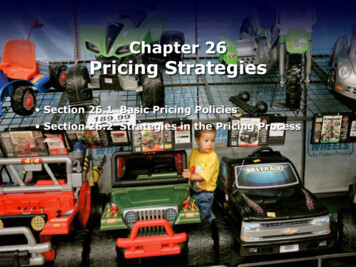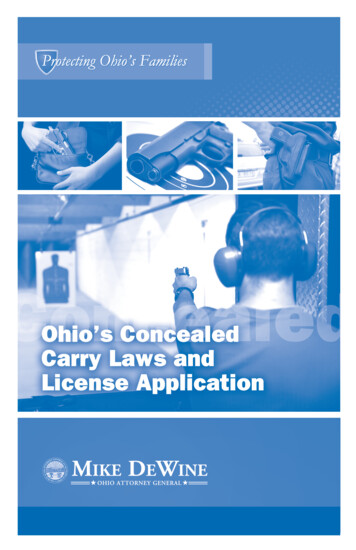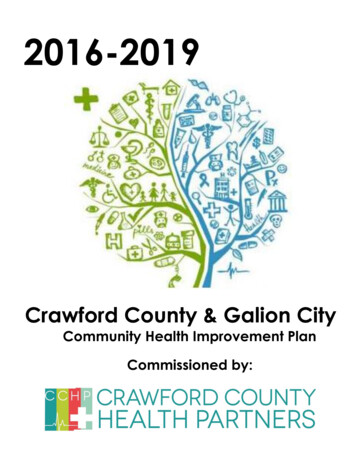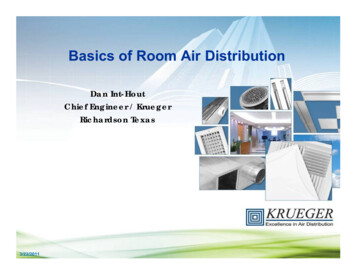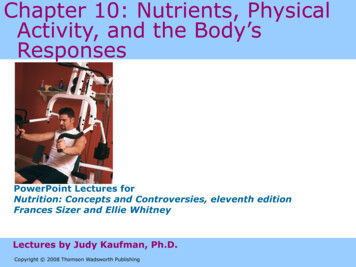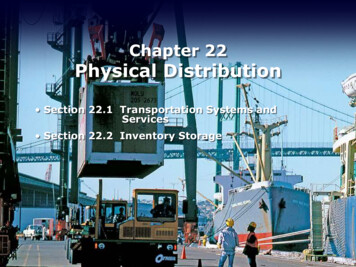
Transcription
Chapter 22Physical Distribution Section 22.1 Transportation Systems andServices Section 22.2 Inventory Storage
Key erscontractcarriersprivatecarriersTransportation Systems andServicesObjectives Describe the nature and scope of physicaldistribution Identify transportation systems and servicesthat move products from manufacturers toconsumersMarketing Essentials Chapter 22, Section 22.1
Key sTransportation Systems andServices Name the different kinds of transportationservice companiesMarketing Essentials Chapter 22, Section 22.1
Transportation Systems andServicesGraphic OrganizerUse a figure to list the advantages anddisadvantages of each type of transportationsystem.Marketing Essentials Chapter 22, Section 22.1
physicaldistributionActivities todeliver the rightamount ofproduct to theright place at theright time.The Nature and Scope of PhysicalDistributionPhysical distribution X comprises all theactivities that help to ensure that the right amountof product is delivered to the right place at theright time.Marketing Essentials Chapter 22, Section 22.1
The Nature and Scope of PhysicalDistributionAlso known as logistics, physical distributioninvolves: Processing Transporting Storing Stock handling Inventory controlMarketing Essentials Chapter 22, Section 22.1
Types of Transportation SystemstransportationThe marketingfunction ofmoving aproduct from theplace where it ismade to theplace where it issold.Transportation X is the marketing function ofmoving a product from the place where it is made tothe place where it is sold. Its costs are a significantpart of each sale, so both manufacturers and sellerslook for the most cost-effective delivery methods.Marketing Essentials Chapter 22, Section 22.1
TruckingTrucks, or motor carriers, are the most frequentlyused transportation mode. They carry goods withshort shelf lives and ones that are expensive for abusiness to keep in inventory.Marketing Essentials Chapter 22, Section 22.1
TruckingState and federal transportation agencies regulatemotor carriers used for interstate (between states)commerce. The laws cover how long a driver can gowithout stopping and other safety issues.Marketing Essentials Chapter 22, Section 22.1
TruckingBusinesses that use trucks to move their productshave several different options: For-hire or private carriers Combination of bothFor-hire carriers include: Common and contract carriersMarketing Essentials Chapter 22, Section 22.1
Types of Transportation SystemscommoncarriersTruckingcompanies thatprovidetransportationservices to anybusiness in theiroperating areafor a fee.Common carriers X provide transportation servicesto any business in their operating area for a fee.Contract carriers X are for-hire carriers that provideequipment and drivers for specific routes, accordingto agreements between the carrier and the shipper.contractcarriersFor-hire truckingcompanies thatprovideequipment anddrivers forspecific routes.Marketing Essentials Chapter 22, Section 22.1
Types of Transportation SystemsFor-hire carriers provide their own equipment, butthey offer less flexibility for: Special pickups or handling Rush deliveries Direct shipmentsMarketing Essentials Chapter 22, Section 22.1
Types of Transportation SystemsprivatecarriersTruckingcompanies thattransport goodsfor an individualbusiness.Private carriers X transport goods for an individualbusiness. The equipment can be owned or leased tomeet the specific transportation needs of thebusiness. Starting a private carrier operation requiresa large investment in equipment and facilities, butthe company has full control.Marketing Essentials Chapter 22, Section 22.1
Types of Transportation SystemsexemptcarriersTruckingcompanies thatare free fromdirect regulationof rates andoperatingprocedures.Exempt carriers X are free from direct regulation ofrates and operating procedures. Their rates are lowerbecause of their exempt status.Some disadvantages of trucks are that they costmore than rail or water carriers, and they aresusceptible to delays.Marketing Essentials Chapter 22, Section 22.1
Types of Transportation SystemsIntermodal transportation combines two or moretransportation modes to maximize the advantages ofeach. Piggyback service is carrying loaded trucktrailers over land on railroad flat cars. Trucks willthen take the trailers to their destinations. Fishybackservice carries truck trailers on ships.Marketing Essentials Chapter 22, Section 22.1
Railroadston-mileThe movementof one ton (2,000lbs) of freightone mile.Trains transport nearly six percent of the totalintercity ton-miles of freight. A ton-mile X is themovement of one ton (2,000 lbs.) of freight one mile.Trains are good for moving heavy and bulky freight,and they can use refrigerated cars to haulagricultural products.Marketing Essentials Chapter 22, Section 22.1
RailroadscarloadThe minimumnumber ofpounds of freightneeded to fill aboxcar.A carload X is the minimum number of pounds offreight needed to fill a boxcar. Carload weights areestablished for different classifications of goods.Marketing Essentials Chapter 22, Section 22.1
RailroadsRailroads are one of the lowest cost transportationmodes because trains carry large quantities atrelatively low per unit costs. The biggestdisadvantage of rail transport is the lack of flexibility.Marketing Essentials Chapter 22, Section 22.1
Marine ShippingWaterway shipping uses three different kinds ofroutes: Inland Intracoastal InternationalMarketing Essentials Chapter 22, Section 22.1
Marine ShippingAlmost all overseas nonperishable freight istransported by container ships and barges. Containerships are the cheapest mode of transportation, butthey are also the slowest.Marketing Essentials Chapter 22, Section 22.1
PipelinesPipelines are most frequently used to transport oiland natural gas from oil fields to refineries.Pipeline construction requires a high initialinvestment, but operation costs are relatively small.Pipelines have the best safety record among majortransportation systems.Marketing Essentials Chapter 22, Section 22.1
Air Cargo ServicesAirplanes are generallyused to ship high-valueitems and things neededquickly, such as: Emergency parts Instruments MedicinesMarketing Essentials Chapter 22, Section 22.1
Transportation Service CompaniesTransportation service companies handle small- andmedium-size packages. Some examples are: The U.S. Postal Service Express delivery services Bus package carriers Freight forwardersMarketing Essentials Chapter 22, Section 22.1
U.S. Postal ServiceThe U.S. Postal Service ships small packages byparcel post or first-class mail. Parcel post canalso be express-mailed at higher rates toguarantee next-day delivery.Marketing Essentials Chapter 22, Section 22.1
Express Delivery ServicesExpress delivery services specialize in deliveringsmall, lightweight packages and high-prioritymail usually weighing less than 150 pounds.Such companies are: FedEx or DHL United Parcel Service (UPS)Marketing Essentials Chapter 22, Section 22.1
Bus Package CarriersBus package carriers provide transportation servicesfor packages weighing less than 100 pounds. Theyoffer same-day or next-day service to cities andtowns along their scheduled routes.Marketing Essentials Chapter 22, Section 22.1
Freight ForwardersfreightforwardersPrivatecompanies thatcombine lessthan carload ortruckloadshipments fromseveralbusinesses anddeliver them totheir destinations.Freight forwarders X are private companies thatcombine less than carload or less than truckloadshipments from several different businesses anddeliver them to their destinations.They gather small shipments into larger lots and thenhire a carrier to move them, usually at reduced rates.Marketing Essentials Chapter 22, Section 22.1
SECTION 22.1 REVIEW
SECTION 22.1 REVIEW- click twice to continue -
Inventory StorageKey utioncenterbondedwarehouseObjectives Explain the concept and function of inventorystorage Identify the types of warehouses Discuss distribution planning for internationalmarketsMarketing Essentials Chapter 22, Section 22.2
Inventory StorageGraphic OrganizerIn a chart like this one, take notes about varioustypes of warehouses.Marketing Essentials Chapter 22, Section 22.2
The Storage of GoodsstorageA marketingfunction thatrefers to theholding of goodsuntil they aresold.Storage X is a marketing function, and it refers tothe holding of goods until they are sold. Theamount of goods stored is called an inventory.Storing goods is essential because: Products are stored until orders are receivedfrom consumersMarketing Essentials Chapter 22, Section 22.2
The Storage of Goods Production can exceed consumption or demandcan decrease Some goods are only available during certainseasons Purchasers will buy goods in bulk at a discountrate and then store them until needed
The Storage of GoodsThe costs involved in storing products include: Space Equipment PersonnelMarketing Essentials Chapter 22, Section 22.2
Private WarehousesprivatewarehouseA facilitydesigned to meetthe specificneeds of itsowner.A private warehouse X is a facility designed tomeet the specific needs of its owner. These can bespecialized environments, such as a climatecontrolled facility. They often house other parts ofthe business operation.Marketing Essentials Chapter 22, Section 22.2
Private WarehousesThe disadvantage of private warehouses is thatthey are costly to build and maintain. They shouldbe considered only when a significant amount ofmerchandise needs to be stored.Marketing Essentials Chapter 22, Section 22.2
Public WarehousespublicwarehouseStorage andhandling facilitiesoffered to anyindividual orcompany thatwill pay for itsuse.A public warehouse X offers storage andhandling facilities to any individual or companythat will pay for its use. Extra services include: Receiving and unloading Inspecting Order fillingMarketing Essentials Chapter 22, Section 22.2
Distribution CentersdistributioncenterA warehousedesigned tospeed delivery ofgoods and tominimize storagecosts.A distribution center X is a warehouse designedto speed delivery of goods and to minimizestorage costs. Its focus is on sorting and movingproducts, not storing them.These centers can also consolidate large ordersfrom many sources and redistribute them.Marketing Essentials Chapter 22, Section 22.2
Bonded WarehousesbondedwarehousesPublic or privatewarehouses thatstore productsrequiring thepayment of afederal tax.Bonded warehouses X, either public or private,store products that require the payment of afederal tax. Imported or domestic products cannotbe removed until the required tax is paid.Businesses use these warehouses because theycan save money.Marketing Essentials Chapter 22, Section 22.2
Distribution Planning forInternational MarketsSelling to customers in the internationalmarketplace requires more planning thanselling domestically. International businessesmust consider other countries’: Import/Export laws and regulations Language barriers and customsMarketing Essentials Chapter 22, Section 22.2
SECTION 22.2 REVIEW
SECTION 22.2 REVIEW- click twice to continue -
Section 22.1 Physical distribution links a business and itscustomers. Physical distribution comprises all theactivities that help to ensure that the right amountof product is delivered to the right place at theright time.continued
Section 22.2 Storage is the marketing function of holding goodsuntil they are sold. Storing goods is an essentialactivity for most businesses. Products are storedin warehouses or distribution centers until ordersare received from customers.
This chapter has helped prepare you to meet thefollowing DECA performance indicators: Explain stock-handling techniques for receivingdeliveries. Describe the use of technology in the distributionfunction. Rotate products. Provide legitimate responses to inquiries. Handle telephone calls in a businesslike manner.
CHAPTER 22 REVIEW
CHAPTER 22 REVIEW- click twice to continue -
The Nature and Scope of Physical Distribution Also known as logistics, physical distribution involves: Processing Transporting Storing Stock handling Inventory control Marketing Essentials Chapter 22, File Size: 377KBPage Count: 47
